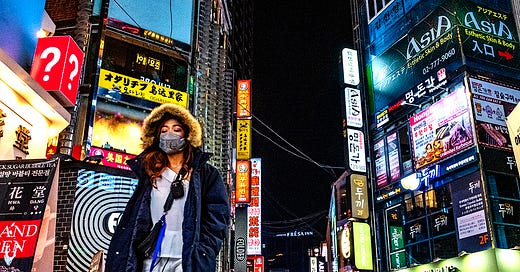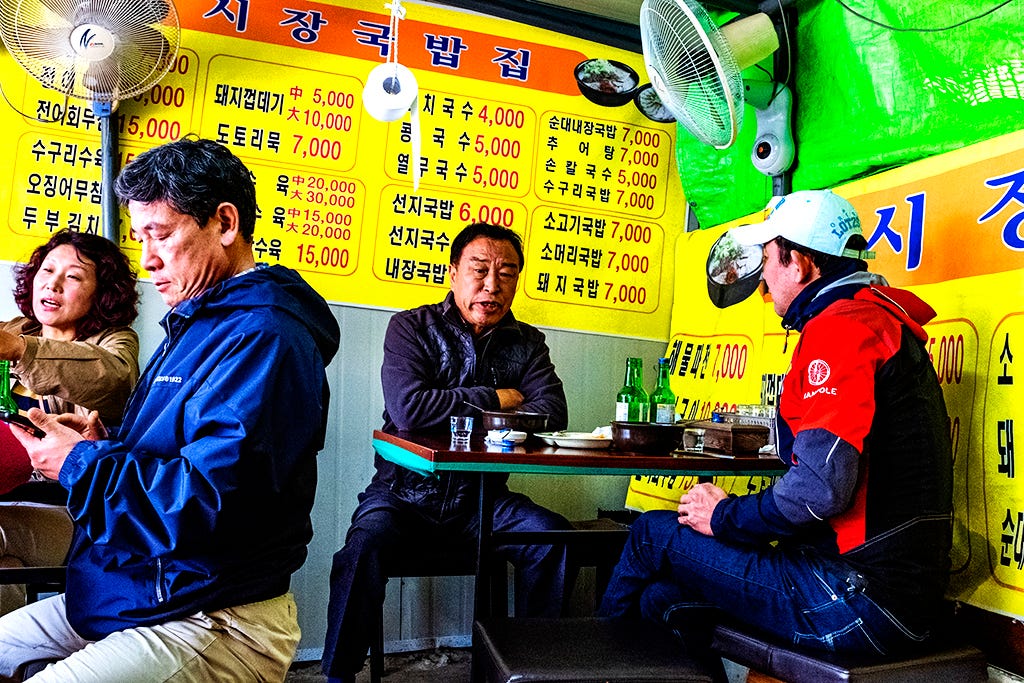[Seoul 3/7/20]
Ah South Korea, the land of convenience stores, pool halls, undrinkable beer, deadly soju, hangover pills, endless kimchi, ugliest churches, heavenly BBQ, fried chicken gluttony, plastic surgery, K-pop androgyny, cutesy love hotels, handjob cafes, Audrey Hepburn infatuation, no street crime, and buses and trains that always run on time!
Though Seoul was much quieter than usual in March of 2020, it wasn’t dead, for there was no lockdown. From my cheapo room, I could stroll through Myeong-dong, with its hundreds of stores and restaurants still open. I had hearty beef bone soup (gomguk) at Hadongkwan, and burgers at Moss, the excellent Japanese chain. I took subways and walked to dozens of neighborhoods, and everywhere, there were still plenty of people outside.
A large sign at a building’s entrance, “In order to prevent the spread of COVID-19, Please Step on the disinfected mat.” Sure, it’s quackery, but at least it’s harmless, unlike official ones. Bullshit from Fauci, Bourla, Wallensky and Zients massacres.
Even before Covid, mask wearing was fairly common in the Orient, in Southeast Asia because of air pollution, while in Japan, because people didn’t want to infect others with anything. During my five months in South Korea, mask wearing was nearly universal outside, but here’s the catch, and joke, no one wore them, of course, in packed cafes and restaurants, so what’s the point? This was my first clue that all was not kosher with the Covid narrative.
Since it was hard to breathe with a mask, many Koreans did it with their nose sticking out, defeating the purpose. This, I would also see in many other countries.
Orientals used to cover their mouth as they laughed or smiled, so that’s a precursor of sort. When I came to the States as an 11-year-old in 1975, I did this until I realized it wasn’t seen as politeness, but ridiculous.
Maskless, Koreans would get trashed at a soju tent, or stuff their face at a fried chicken joint, whooping it up with friends, perfectly relaxed, then they would line up at a pharmacy to buy many more masks. It would not be nice, nearly an antisocial act, to go maskless on a subway or bus, or just strolling down a busy sidewalk. When it’s booze time, however, and Koreans consume ungodly amounts of terrible Cass, Terra and Hite, etc., there was no social distancing whatsoever, fuck Covid, with all mouths and noses completely gaping to the rest of humanity, because, hey, we’re all in this together!
[Daegu, 3/10/20]
After ten days in Seoul, I took a train to Busan on 3/11/20, so had my first glimpses of Daegu, passing by outside my train window. During a brief stop at its station, the relative desolation of the platforms was frankly thrilling, and I watched people getting off with fascination and pity, for they were marching into a plague-racked city, I thought.
After checking into my room in Busan, I returned to Daegu the very next morning. Clearly, I couldn’t wait to have Corona-Chan breathe on me, with my nervous, excited hand on the small of her back. At the Busan Station, I bought my ticket with something like embarrassment and guilt, as if I was headed to an orgy at a mass funeral.
Covid was brought to Daegu by a 61-year-old evangelist, returning from China. Though less than a third of South Koreans are Christian, they can be very fervent about it. Per capita, South Korea is second only to Spain in sending out Christian missionaries. A year later in Kukes, Albania, I would find a Korean missionary, preaching in Albanian.
My tryst with Corona-Chan in Daegu turned out to be rather lame. Though the city was deadened, there were still people out and about, working or just enjoying themselves. At a riverside park, I mingled with dozens of strollers. At Shinsegae, a huge high-end mall, traffic was embarrassingly thin, but all the shops were open.
On two subsequent visits, I found Daegu much more normal, with most of its liveliness restored. Passing the Shincheonji Church, ground zero of the country’s Covid outbreak, I noticed it was still shuttered, however. Covid killed it.
With China then South Korea hit by Covid, there were speculations it was a bioweapon targeting only Orientals, but by 3/7/20, Iran already had 107 Covid deaths, and Italy 197, so that theory was ditched. Italy had a large Chinese population, so it’s likely Covid was brought back by Chinese returning from their new year’s holiday, but how did it get into Iran? Never reliable Wikipedia claims that Chinese also brought it to Qom, but others, including the Iranian government, suggested it was an American bioweapon aimed at a perennial enemy. By 3/25/20, at least 17 Iranian politicians or high-ranking officials had died.
Initially insisting that Covid jumped from bat to man, the official narrative in the West would, nearly a year later, shift to it being a bioweapon leaked from a Chinese lab. Yet, after China had pretty much returned to normal, Western governments implemented a series of totalitarian measures with Covid as a pretext. Adhering to a remarkably uniform agenda, they needed Covid to enforce toxic “vaccines” and “health” passports, for those who survive.
Since China was already a totalitarian regime, with its social credit system a model and inspiration for the West’s “health” passports, it didn’t need Covid for anything, least of all a crippling of its own economy. Locking down all of its vast territory, China’s overreaction to Covid also suggests it had no idea what hit it.
Those who label Covid a Chinese bioweapon against the US are clearly doofuses, but those who think it’s merely an American roundhouse against China and Iran are still clueless. To push that in 2022 is a misdirection.
A globalist weapon, Covid has a global reach. Governments, especially Jewjacked Western ones, are warring against their people.
[to be continued, of course and unfortunately]
[Busan, 4/12/20]






"Jewjacked", new word to me. Pt. IV should be very interesting. Mazol tov amigo.